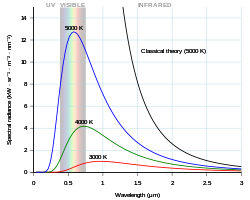Planck's law
describes the amount of spectral radiance at a certain wavelength radiated by a black body cavity in thermal equilibrium
Planck's law describes the spectral density of electromagnetic radiation emitted by a black body in thermal equilibrium at a given temperature T. The law is named after Max Planck, who proposed it in 1900. It is a pioneering result of modern physics and quantum theory.

Related pages
change